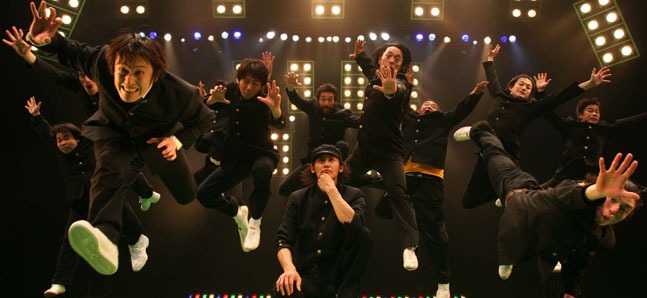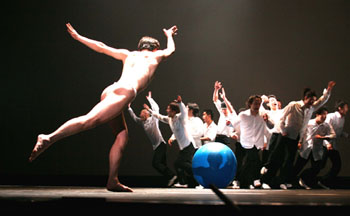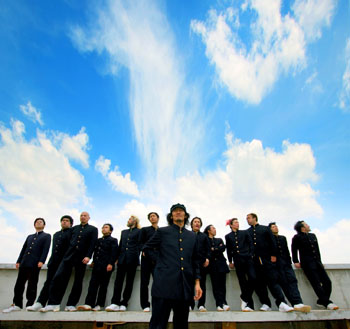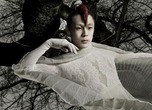Why the world loves the Condors
The Condors take you up into a dazzling sky with a new tour

Photo by Haru
Posted: Thu Sep 23 2010
Producer and performer Yasuharu Katsuyama, from the popular Japanese dance troupe Condors laughingly says, ‘I think that part of our popularity comes from us being a kind of manifestation of culture in Tokyo’ – words that express the Condors (a group that the world has called ‘hugely entertaining’, ‘impressive’ and ‘irrepressible’) down to a tee.
It’s been over fifteen years since the group’s leader, Ryohei Kondo, graduated university and put together this all-male group of highly talented, unique individuals who, dressed in their trademark gold-buttoned black school uniforms (known as gakuran), have gone on to set new standards in entertainment and dance their way to near-idol status in Japan. In terms of genre, the group falls into the category of ‘contemporary dance’; however, they aren’t exactly your typical, perfectly synchronized, perfectly built ensemble. On the contrary, one of the members is 190cm tall and another, who carries the nickname ‘Chibe de Debu’, is quite the opposite (chibe meaning short and debu meaning fat).
In fact, you could even go as far as to say that, for a dance group, they consist of one of the most unlikely bunch of ill-assorted misfit members imaginable. Judging by their appearance, the group looks like nothing more than simply a collection of perfectly ordinary men (albeit men dressed in school uniforms that is), the likes of which you might expect to see anywhere in Japan. However, in reality, this particular group of men are anything but ordinary – a fact that soon becomes apparent when they begin to dance.
However, the Condors don’t just dance; in the same way that music albums are made up of different tracks, a performance by the Condors is made up of different acts, involving skits, scenes involving moving imagery or even puppets. Furthermore, each act is often vastly different from the next – there might be a man dressed in nothing but a loincloth performing a relatively serious dance on stage one minute, and a scene that takes place by a stand selling kebabs on a Tokyo street corner the next.

Regardless of the fact that some of the skits can only be described as absurd, the group performs them with nothing less than a devotion that often stretches their middle-aged muscles to breaking point. Plus, each and every one of the group’s members represents a character that audiences can’t help but find absolutely fascinating. Rather than appearing as merely a collection of highly entertaining individuals, the group melds together to create a collaborative spectacle that leaves audiences feeling completely satisfied. The Condors have performed in over 20 countries worldwide and boast acclaim from the New York Times – making a previous gag in which the group proclaimed ‘rave reviews from the New York Times’, actually come true.
Jumping slightly ahead; a particular female member of the diet attracted an incredible amount of media attention some time back, when she famously commented, ‘Do we need to be number one? Isn’t number two good enough?’ She said this in regard to significantly large, newly proposed investments in the fields of science and technology during a review of government programs being held by the democratic party of the time – which admittedly may not have been the cleverest of things to say considering the major role that science and technology has historically played in the development of Japan as a nation. However, by voicing her opinion, perhaps what she was actually trying to criticise was the way that Japanese people all too often focus on being ‘number one’.
The leader of the Condors, is artistic director and choreographer Ryohei Kondo (whose name actually forms part of the name of the group). After being raised in South America (his father was placed there by the major trading firm he was working for at the time), Ryohei returned to Japan and graduated from Yokohama National University, one of Japan’s top universities. It’s not just Kondo who attended one of Japan’s top universities, with other members of the group having graduated from Tokyo National University of Fine Arts and Music, Gunma University and Waseda University. However, Kondo never chose to dedicate his life to helping Japan sell its resources and commodities abroad as his father did; instead, he chose something different – leaving the democrats (such as the lady mentioned in the preceding paragraph) to eagerly debate the best growth strategy (i.e., the best way to help Japan ‘put food on its table’) for themselves.
From the very beginning, producer Katsuyama told the other group members, ‘Second best is good enough, if there’s something else that any of us would rather be doing then we should prioritize that instead. There’s no need to let your life go to pot by working yourself into a frenzy; if we work too hard at trying to succeed, then desperation will show in our work and things will end up being boring’ – a stance that’s normally associated with groups who perform unprofessionally. However, rather than remain in the shadows, the Condors have become a leading Japanese dance group capable of continually selling out major venues – a fact that has perhaps come to fruition precisely as a result of their ‘second best is good enough’ attitude and the fact that, in reality, Katsuyama was striving to make the Condors the very best group they could be.
Katsuyama: ‘Whilst telling the other members that second best is good enough, the truth is that I actually thought we could be the best if we were just given a chance. Even when we were just starting out, I remember thinking that we were already more interesting than the other groups on the scene. However, because we were so original, to begin with, people criticized us with comments such as “they have no idea what they are aiming at”… although, when you think about it, that kind of criticism was to be expected; after all, we ourselves hadn’t yet worked out how to express what it was we were aiming at. We just believed in ourselves and got on with it.’
In saying that ‘second best is good enough’ Katsuyama wasn’t being weak or defeatist. Instead, his words were merely an indication of a certain type of coolness that’s typical of a truly Tokyoite attitude. From Yasuharu’s book ‘Condors Keppuroku!’ (Popular Publishing):
‘Everywhere you look there are people who feel smothered by a sense of helplessness. In the same way that water flows from high to low, in general, if left to their own devices, people will naturally think negative thoughts. Which is precisely why those of us who create things, should rise to the challenge of using our positivity as a tool to help create a better future; because, although it's the hardest challenge we may ever face, its also the most worthwhile.’
With the recent news of China’s GDP surpassing that of Japan’s, Japan is faced not with having the world’s second largest economy, but the third; and according to a survey conducted by a particularly well-known newspaper company, the number of Japanese people who view this as a ‘problem’ aren’t all that great in number. However, although it’s often said that the Japanese aren’t a very internationally minded group of people, a considerable number of Japanese people venture outside of Japan, before returning home to share their experiences with others – the influences of which are particularly prominent in Tokyo.
Displayed in the entrance to the Condor’s office are the English words ‘We’re Open’. Yasuharu himself has previously used the words ‘a group of punks’ in describing the Condors, and in doing so what he’s really getting at is the idea of freedom – an idea that has resonated with Japanese people in general and has helped the Condor’s achieve an overwhelming popularity. To anyone fretting over how best to live their lives, rather than how Japan can best put food on its table, the idea of freedom that the Condors embrace might be just the answer they’ve been looking for.
The flyers for the Condor’s new tour, entitled ‘Sky with Diamond’, display a photograph of the group taken under a blazing Jakartan sun, and promise ‘a performance like you’ve never seen before’. Plus, the dazzling blue sky in the photograph, which inspired the title of the tour itself, does nothing to hinder the idea of being taken into a world ‘like you’ve never seen before’. With a new performance, entitled ‘Yasashikute Iyashikei’ (‘Gentle and Soothing’), the Condors look at you with nonchalance and say ‘We’re Open’.

Website: www.condors.jp/
Tweets
- About Us |
- Work for Time Out |
- Send us info |
- Advertising |
- Mobile edition |
- Terms & Conditions |
- Privacy policy |
- Contact Us
Copyright © 2014 Time Out Tokyo














Add your comment